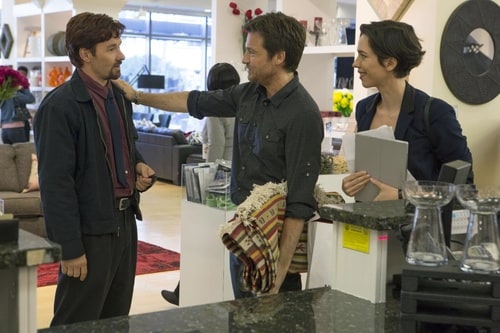Jason Blum has carved out a lucrative career as a producer by backing low-budget horror flicks, leading to about as many dexterous fright machines (Insidious, Sinister) as flaccid misfires (The Purge, Ouija, The Lazarus Effect). But 2015's The Gift is a different animal altogether. Rather than a tacky horror pic, this directorial debut for Joel Edgerton is a Hitchcockian psychological thriller, relying on proper suspense, competent storytelling and powerful acting. Also written by Edgerton, the narrative is built on the simple premise of what would transpire if the bully and the bullied were reunited decades on, and the result is confidently unpredictable and deliciously intriguing. It's the perfect antithesis to the year's noisy blockbusters, and though it does have its shortcomings, it's easy to admire Edgerton's valiant efforts on the picture.
Finding a new job outside the city, Simon (Jason Bateman) and his wife Robyn (Rebecca Hall) move to a suburban Los Angeles neighbourhood where Simon grew up, ready for a fresh start. The couple are still haunted by traumas of the past, with Robyn opting to work from home while she deals with her mental roadblocks. While shopping, the pair are approached by Gordon (Joel Edgerton), an old classmate of Simon's who seems to have good intentions, latching onto the married couple instantly. In the ensuing weeks, Gordon sends gifts and shows up at the couple's residence unannounced. Robyn finds Gordon to be nice enough, despite his social oddness and palpable loneliness, but something about Gordon just rubs Simon the wrong way. Moreover, Simon is uncomfortable discussing past events, prompting Robyn to investigate Gordon's history with Simon.
Edgerton, an Australian actor who has starred in dozens of movies over the past two decades, is not new to screenwriting; he wrote Felony and had a hand in penning the insanely underrated The Square. It's clear that his past experiences have served him well - The Gift may be imbued with familiar tropes, but the script manages to subvert expectations at every turn, creating an air of head-slapping ambiguity, and it helps that the execution is so thoroughly engaging, revealing darker depths and layers to the story that we might not have expected from the outset. It's the way Edgerton plays with expectations that elevates The Gift above less skilful thriller efforts, questioning who the real villain is and raising tension as the story plays out. Even though the story climaxes with a sense of righteous vengeance, the movie nevertheless closes on a note of solemnity and loss, with scars of the past still as tender as ever. Even though The Gift isn't the most pleasant motion picture, it's certainly a harrowing watch.
It's clear that Edgerton is a major talent behind the camera, drawing influence from the likes of Alfred Hitchcock and David Fincher, with a touch of Roman Polanski's Rosemary's Baby. The first-time director shows particular promise as an architect of discomfort, with the script merely suggesting that Gordon has an insidious plan for the couple, even when there's little evidence to definitively confirm the accusations. Admittedly, a few instances of jump-scare theatrics do not entirely gel with the slow-burning nature of the narrative, but the two or three silly moments aren't enough to undo the movie's limitless strengths. Edgerton was nervous about directing his first production, especially since he was also required to act, ultimately bringing in his more experienced brother Nash (who helmed The Square) to assist. The Gift benefits from the slick, polished cinematography by Eduard Grau, while the picture is tautly edited by Luke Doolan, with no scene or moment outstaying its welcome. Every cent of the $5 million budget was visibly put to great use, while the score by Danny Bensi and Saunder Jurriaans is pulsing and atmospheric, impeccably complementing the visuals.
Who knew Jason Bateman was such an adept dramatic performer? The actor is frequently the proverbial straight man in comedies, but here he utterly disappears into the role of Simon, and it really is a sight to behold. He sells fear and frustration, on top of being enormously charismatic and likeable, and an emotionally charged scene of Robyn confronting Simon about his past behaviours features the best acting of Bateman's career. Bateman nails it, showing that we really have underestimated him for so many years, and further roles in this vein would be an enticing prospect. Equally terrific is Edgerton, who puts his all into the role of “Gordo,” delivering a tremendously assured and above all nuanced performance unlike anything the actor has ever done. And best of all, no trace of artifice betrays his acting; his Aussie accent never shines through. A director starring in his own movie may seem gimmicky, but it's hard to imagine any other actor filling this pivotal role. Hall, meanwhile, confidently keeps pace with her co-stars, perhaps delivering the finest performance in the movie, which is not a statement to be taken lightly. Astonishingly believable from start to finish, Hall is able to convey what she's feeling just with her eyes; she says so much with minimal dialogue. This is very much an actor's movie, and thus it's fortunate that the trio of leads are so pitch-perfect.
The Gift does fall short of perfection, with subplots involving Robyn's drug abuse and Simon's paranoia that are ultimately undercooked, but it's nevertheless one of the strongest thrillers to be produced under the Blumhouse banner. What's particularly remarkable about The Gift is that it's not a thriller in which characters accept pre-defined roles of good and evil, with the layered, complex leads elevating what would otherwise be a paint-by-numbers fright machine. Add in a daring conclusion that examines the grey-scale morality of the parties involved, and you have one of the most satisfying movie-going surprises of 2015.
8.2/10
 Login
Login
 Home
Home 183 Lists
183 Lists 1671 Reviews
1671 Reviews Collections
Collections



 1 comments,
1 comments, 







































